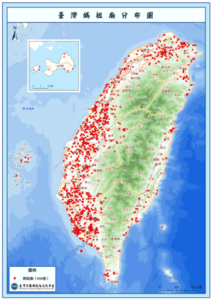
Widespread devotion to Mazu in Taiwan is likely due to the seamless integration of folk religion into everyday life, which contrasts with more structured faiths like Christianity or Islam that often require formal initiation and exclusive allegiance. For most worshippers, a visit to a Mazu temple involves lighting incense, offering prayers for blessings or seeking protection- particularly for those in professions linked to the sea, such as sailors and fishermen. These visits are characterized by vibrant altars, detailed statues of Mazu and the ceremonial music that often accompanies major festivals like Mazu’s birthday. Mazu worship is inherently inclusive, allowing devotees to venerate other folk gods alongside her without conflict. This flexibility, combined with the emphasis on communal rituals and festivals, strengthens social ties and reinforces cultural identity, making the faith a deeply embedded part of Taiwanese life.
The Mazu faith does not have a permanent clergy. Temple affairs are often led by management committees or boards of directors, which are composed of representatives elected by local believers. These committees oversee temple operations, festivals and maintenance, ensuring that the organizational direction reflects the collective will of the community. While each temple is generally autonomous, more prominent temples may provide guidance to smaller ones in their orbit, such as instruction in ceremonial practices or opportunities to partake in shared religious activities like incense exchange or pilgrimages.
In modern Taiwanese society, Mazu now holds the revered title of “Queen of Heaven” (天后, Tiānhòu), and is regarded as the highest-ranking female deity. In recent years, however, the Chinese government has given her an additional title: the “Goddess of Peace in the Taiwan Strait” (海峽和平女神).

Notes
- Chiu, K.P. (2010, June). 台灣媽祖信仰傳承之個案研究–以2009台北縣媽祖文化節為例( The study of the Passage of Matsu Belief in Taiwan: Case of 2009 Taipei County Matsu Cultural Festival ). Airiti Library, https://www.airitilibrary.com/Article/Detail/a0000246-201006-201209120017-201209120017-131-139., p. 131-13.